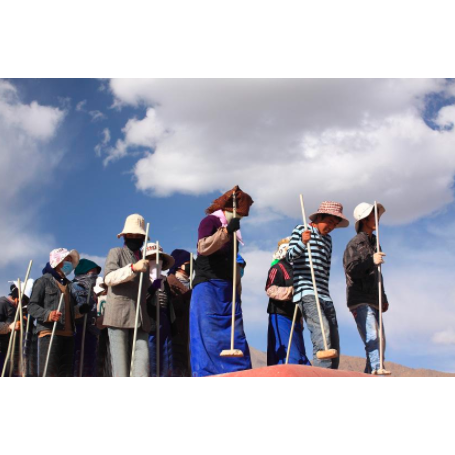aga overview
 Aga (pinyin: Ā gā), a Tibetan body-sounding musical instrument. Popular throughout the Tibet Autonomous Region. It is a rammed musical instrument, which is made by inserting a long wooden stick into a flat round stone. The stone diameter is 12 cm to 18 cm, the stone thickness is 2 cm to 4 cm, and the length of the wooden stick is 130 cm to 150 cm. The diameter of the wooden stick needs to match the stone hole.
Aga (pinyin: Ā gā), a Tibetan body-sounding musical instrument. Popular throughout the Tibet Autonomous Region. It is a rammed musical instrument, which is made by inserting a long wooden stick into a flat round stone. The stone diameter is 12 cm to 18 cm, the stone thickness is 2 cm to 4 cm, and the length of the wooden stick is 130 cm to 150 cm. The diameter of the wooden stick needs to match the stone hole.Aga is a labor tool used by construction workers when building houses. In Tibet, whether the flat roof or indoor floor of the house is built, it must be rammed by a special kind of clay, Aga clay.
The rammed earth is mostly operated by female workers. The women hold Aga and smash, sing and dance on the ground covered with Aga. First, smash and smash the dry Aga soil. At this time, the song and dance are called "Axie", and then watered to level and smash it. At this time, the song and dance are called "Lumxie", whether it is dry or wet. , the female workers all hold Aga in their right hand, and sing and dance rhythmically while smashing.
Before the emergence of modern building materials such as cement and concrete, bricks, tiles and lime were used as the main masonry materials in ancient buildings in the Mainland. Due to the oxygen-deficient natural environment of the Tibetan Plateau, it is extremely difficult to burn bricks and tiles, and it is difficult to find building lime that meets the standard due to the unique geographical environment of Tibet. It has become a unique creation in the ancient Tibetan architectural craftsmanship.
Since the 1950s, Tibetan literature and art workers have brought this folk labor song and dance to the literary stage and created the life-like "Aga Dance". Aga is both a musical instrument and a dance prop.
- Pinyin:Ā gā
- type:Tibetan falling down body singing musical instrument
- popular area:All over the Tibet Autonomous Region
- Production Method:A long wooden stick is inserted into the flat round stone
overview of other similar instruments
- sanyanxiao overview
- Daguangxian overview
- Leiqin overview
- hahao overview
- yandundagu overview
- Han Xiaozheng overview
- Fang Xiang overview
- guanzi overview
- zhuqin (Dao Qin) overview
- zhuiqin overview
- bangzi overview
- three-stringed piano overview
- Gehu overview
- xiao overview
- xiaokonghou overview
- Konghou overview
- Sheng overview
- suona overview
- hulusi overview
- gushao overview
 渝公网安备 50010702504639号
渝公网安备 50010702504639号